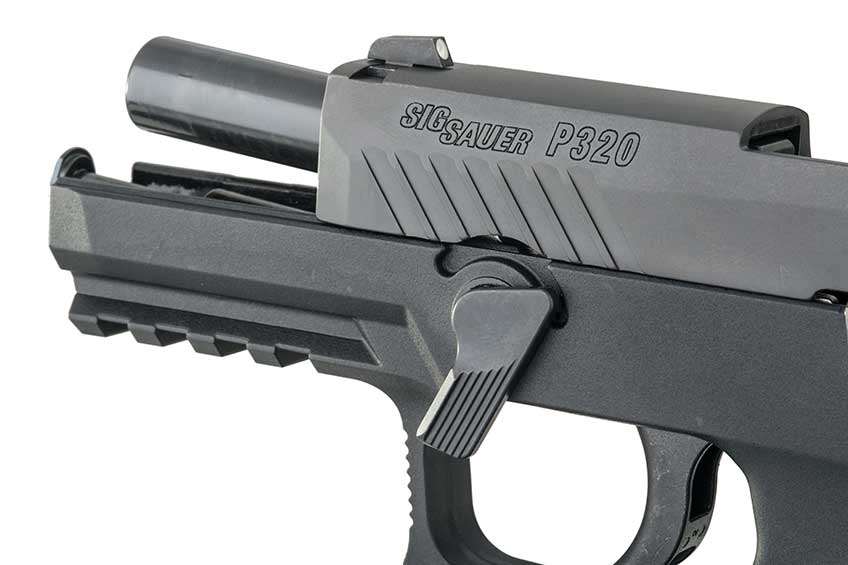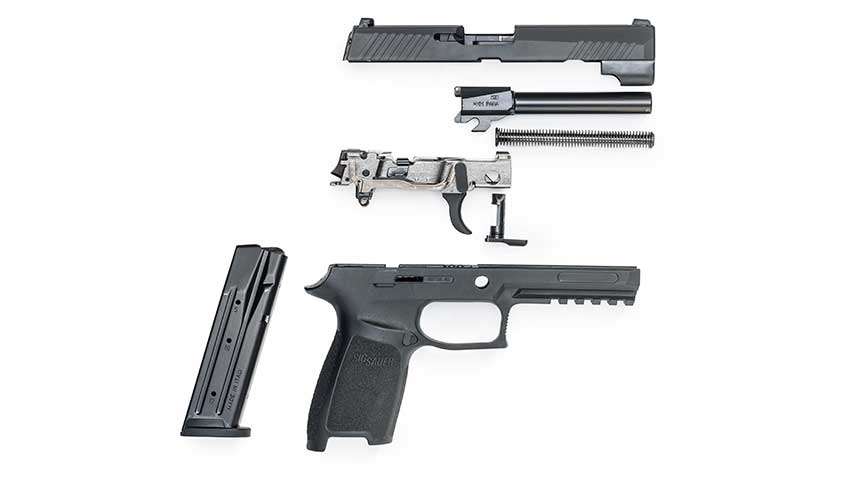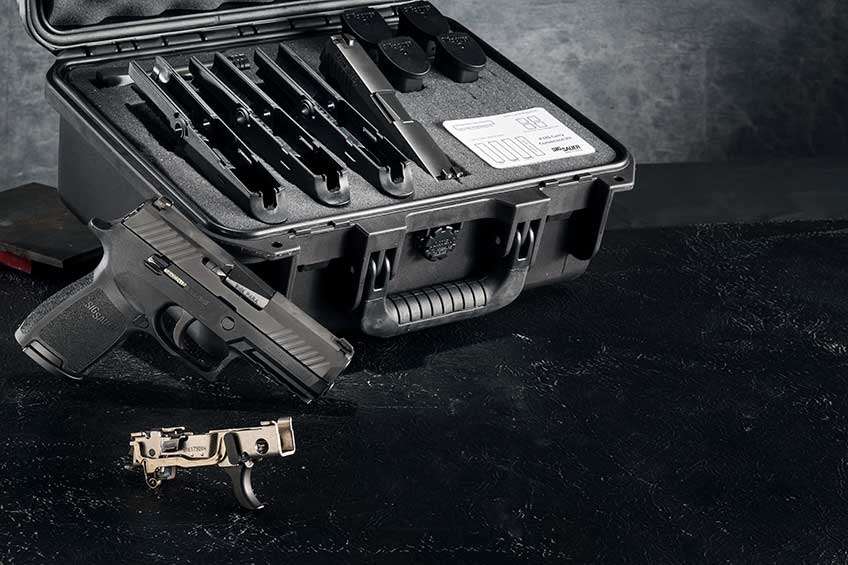
This article, "Tomorrow's SIG Today," appeared originally in the April 2015 issue of American Rifleman. To subscribe to the magazine, visit the NRA membership page here and select American Rifleman as your member magazine.
The versatile, new striker-fired SIG Sauer P320 is really a whole new family of guns from the New Hampshire maker. One single “pistol” can become a full-size, compact or subcompact handgun—each with three different grip sizes.
They have that SIG look to them—blocky slide sitting well above the receiver, gracefully shaped butt section, simplified controls. Unquestionably, a strong family resemblance that says the innovative designers up in New Hampshire have a new series of pistols ready for your consideration.
However, there are several features that are quite different, and the most significant is the absence of a conventional hammer. The guns are called the P320 series, and I had access to the first two offerings—the full-size P320 and the P320 Compact model—for this article. Both sample guns were 9 mm Luger semi-automatics, but .40 S&Ws, .357 SIGs and even .45 ACPs are on the horizon.

The most obvious change in the P320s, as I alluded to, is that the pistols are striker-fired. This means that the actual act of hitting the primer of a chambered cartridge occurs when the spring-loaded striker is released to snap forward and fire the gun. Previous SIG Sauer pistols had a pivoting hammer designed to strike a firing pin, housed within the slide assembly, and, after the shot was fired, a firing pin spring would retract the pin.
P320s are different in that the striker is driven forward by a spring. The striker is cocked when the slide moves all the way to the rear, either manually or during recoil. Though the mechanical processes are different, the end result is the same—both methods produce a satisfying “boom” when you press the trigger.
Since the 1970s, SIG Sauer’s semi-automatic pistols have used the conventional exposed hammer with visible spur. For most of that time, it paired the hammer to a unique double-action/single-action trigger system with no manual safety. The design did, however, include a decocking lever that permitted the handgunner to safely lower a cocked hammer.

Unquestionably, that system has stood the test of time. The maker has tried other trigger systems, including a slick double-action-only system called the Kellerman; but there are hundreds of thousands of SIG Sauer pistols (including the government-issue M11) that deliver excellent service with the original, uniquely SIG lockwork.
So why is SIG Sauer just now getting around to a striker-fired pistol? The simple answer is that many handgunners are—rightly or wrongly—determined that the striker-fired gun is the way to go. There is even a segment of the handgunning world that believes polymer is the modern way to build pistol receivers and old-fashioned steel or aluminum alloys are outmoded.
Polymer does have advantages in weight and contouring, but the reality is that metal receivers have other advantages and that is why they are still with us. The point is simply that we now have more options. SIG Sauer is building the P320 for those handgunners who want a SIG with a polymer receiver and a striker-based firing system.

To get those features, SIG turned to its last all-new product introduction—the P250 pistol. That 2008 rollout involved a bold step forward in modularity. The gun’s system was built around a metal lockwork frame that housed the hammer, trigger, sear and related parts and was marked with the serial number.
The frame slipped into a variety of different grip modules to form a complete pistol receiver, onto which a slide assembly could be fitted—that part includes the slide, barrel, striker and recoil spring. Caliber was determined by the barrel and recoil spring, and capacity depended on the cartridge-specific magazine. It was a remarkable system that enabled the owner of the lock and appropriate parts to change his/her gun into different calibers, barrel lengths, magazine capacities and, best of all, different receiver sizes.
The majority of P250s used SIG’s original DA/SA trigger systems and were hammer-fired. Since much effort went into engineering special magazines and grip modules for the P250 system, those parts were used as the starting point for the new P320 series guns, as well.

That brings us to the P320 guns to be reviewed here. At the time of writing there were two versions available, the Full-Size and Compact, both in 9 mm Luger. There will be several other variations, such as the Carry and Subcompact models, as well as the full range of calibers. Taking the Full-Size P320 service pistol first, we have a large holster gun that boxes 8.05"x5.51"x1.38" (length, height, width) and weighs 29.4 ozs., empty.
On this larger version of the gun, the barrel is 4.69" long. Also, the sheet-steel magazines hold 17 rounds of 9 mm Luger ammunition. With a round chambered and a full magazine in place, the on-tap total is 18—or nine fast pairs. Both front and rear sights are dovetailed into the top of the slide and are drift-adjustable for windage. The sample pistols both had SigLite night sights, a tritium three-dot system.
The maker describes the trigger system on this gun as DAO, which means the internal striker is cocked by the movement of the recoiling slide. Trigger pressure completes the last bit of cocking, as well as clearing internal safeties. Simply relaxing the trigger finger returns internal drop safeties to the set position.

In the operational sense, the P320 is a very simple gun to operate. It has no manual safety and no need for one. Since there is no hammer to cock, there is no decocking lever. Here, the trigger pull is the same for every shot. The only tactical control that’s needed is a slide lock, and then only in the case of clearing certain feedway malfunctions. On this gun, there are slide lock levers on both sides of the receiver. The magazine catch may be reversed for use by left-handed shooters.
Now, let’s take up the P320 Compact. Most of the description of the Full-Size gun applies equally to the Compact. The differences are in dimensions. The shorter Compact has a 3.86" barrel and weighs 25.1 ozs. It measures 7.20"x 5.29"x1.38" and has a slightly shorter magazine that takes 15 rounds of 9 mm Luger.
I can remember when another maker offered 14 rounds in its magazines and lost sales to those who had 15-rounders. Guns have evolved since those days, and we now have smaller plain-clothes guns that boast the same capacity of original service guns. The Compact is the same width as the Full-Size model, but shorter in overall length and height. It is a very attractive package.

Another feature is common to both models, an accessory rail on the so-called “dust cover” which is the underside of the receiver just forward of the trigger guard. This is a feature that is standard on many fighting handguns in the 21st century. It permits the user to mount a variety of different lights, lasers or combinations thereof for use in special shooting situations. In doing so, it unquestionably improves the utility of the gun. At the same time, it does little for the pistol’s aesthetics.
The ergonomics of the P320 pistols are superior. In the original P250 series guns, SIG Sauer went to great lengths to capitalize on the ergonomic advantages provided by using a polymer mold. It really put a lot of effort into shaping the butt section of those pistols, and that rolls over to the P320 guns.
It is a very good shape, with a deep pocket for the web of the hand, a proper grip angle for trigger control, recessed approaches to the rear of the trigger guard and a squared notch at the bottom rear of the magazine well. This latter feature permits the shooter to get a good hold on the magazine in order to rip it out of the gun in the unlikely event of a feedway malfunction. However, the modularity of the grip system is superb.

For each size gun (Full-Size, Carry, Compact and Subcompact), SIG Sauer offers three sizes of grip modules (small, medium and large). The inside of each is the same, with correctly dimensioned magazine well, and pocket for the frame assembly. But the outside of each grip module is thicker or thinner. The actual circumference of the grip is bulkier as the sizes increase.
By this means, the company tailors the pistol to just about any hand. It is a very big deal when it comes to selling the gun, particularly to law-enforcement agencies that buy in quantity for many different-sized hands. The guns are shipped with medium grip modules, as that size fits the greatest majority of shooters. Others are available from the maker, as are a number of other accessories. Please note that SIG Sauer will offer a tabbed trigger safety if you feel you need it.
In the process of making the P320 from P250 magazines and grip modules, the company designers made a major change to the slide contour. Instead of a squared upper edge on each side of the slide, they beveled it. The bevel is formed at an angle that gives the gun a wedge-shaped appearance. It’s kind of racy looking, but has an advantage when it comes to re-holstering. All things considered, these new P320 series guns present a very simple, yet businesslike, appearance.

In the hand—with medium grip modules in place—both the Full-Size and Compact P320s are controllable, even in fast-paced shooting exercises. There is a tendency for the pistol to twist in a counter-clockwise manner, which I believe is a result of a heavy slide cycling on a rather light receiver—one of those peculiarities of certain pistols. A strong stance and positive grip usually solves it.
Also, I noted zero malfunctions with the 200 or so rounds of modern, quality ammunition I ran through each gun. That includes deliberate limp wristing and shooting the gun in odd positions like ejection port up, ejection port down, even upside down—it always worked.
The trigger takes some getting used to. It is a DAO type, with a pronounced take-up to where the actual trigger pressure begins. About 5 lbs. of smooth pressure later and the trigger breaks cleanly. The key to accurate follow-ups is using the short reset as it was designed to be used. In this technique, the shooter pulls all the way through and fires the first shot, but holds the trigger all the way back.
For a second shot, he or she releases the trigger slightly and gets a slight click. This is a signal that the lockwork is set to fire again. Squeeze off another and repeat as many times as is necessary. If there are no more targets, the trigger finger goes straight along the receiver.

Remember NRA Safety Rule No. 2—keep your finger off the trigger until ready to shoot. Practicing the trigger reset takes many repetitions of the above drill, but rewards the diligent with mastery of the pistol.
In the absence of Ransom Rest inserts, I fired the gun off sandbags in the protocol used by this magazine. The ammunition used was all new and fresh. It included the first I had fired of SIG Sauer’s new line of proprietary ammunition. Accuracy was very good with all three loads used. I am impressed with the fact that the average five-shot group is not materially different from one brand of 9 mm Luger ammunition to another.
The P320 is obviously the system designed to carry the SIG Sauer banner deep into the 21st Century, going up against such impressive names as Ruger, S&W, Beretta, HK, FN and Glock. Only time can really tell which marquee—if any—is going to win the big service pistol race, but it seems clear that the P320 is as good as any and probably better than most.





































